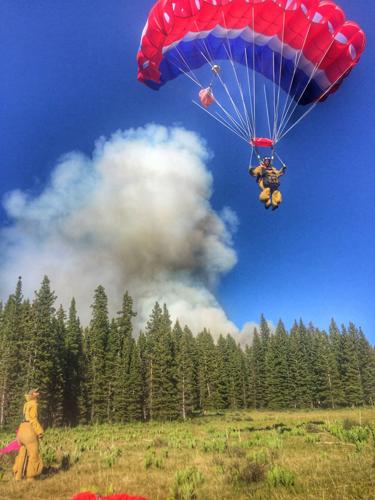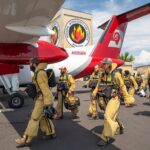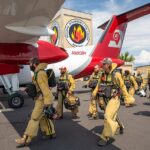
By Seth Boster Special from The Gazette
As part of her annual spring training before another summer of parachuting out of aircraft to tend to fires in remote wilds around the West, Martha Schoppe had a choice.
The Coloradan could opt to run 1½ miles in under nine-and-a-half minutes. Having competed in a 100-mile trail race a couple of weeks before, Schoppe felt her muscles weren’t up for the speed. The other option sounded better: 3 miles in under an hour with 110 pounds strapped to her back.
She clocked in at 36 minutes, 18 seconds. Officers were wide-eyed there at the smokejumper base in Boise, Idaho.
“I guess it was one of the fastest times they’d seen,” Schoppe said.
There she went again, defying expectations.
Everyone in her line of work is defying expectations, all of America’s estimated 400 smokejumpers called to fight burns only accessible by the brave who jump from thousands of feet above. This is an elite breed, a group with enough experience in the field and enough strength, body and mind.
Schoppe had her seventh return to pre-season training last month. And it was intense as ever — a month of running, push-ups, pull-ups, sit-ups, sky dives and tree climbs, necessary for when a smokejumper lands in a tree and must scale down, or when one must retrieve supplies dropped in the canopy.
The fitness tests are for obvious reasons. The job requires hoofing rugged terrain for hours on end, hauling heavy provisions, hand tools for digging ditches and cutting timber, and tents and sleeping bags for unknown nights ahead.
Smokejumpers are the few, the proud of firefighting. Even fewer are women. Around the country in recent years, they have been counted on two hands.
Schoppe, 43, shrugs this off. “I try not to think about it,” she said. “But I do love to be a role model, going to schools and talking to kids. I think it’s good for them to see women in roles like this.”
Good also for the rookies who show up to training. Not all have what it takes.
“Hopefully it’s a strong class this year,” Schoppe said, looking on in Boise. “Get as many as possible.”

As many as possible are needed in this historic age of wildfires, bigger and more destructive than ever, and raging past summer.
Smokejumping appealed to Schoppe for the seasonality. She could work in the summer to afford a fall and winter in her home in Durango, where she could live her other life: mountain biking, skiing, climbing, pumping iron, training in the San Juans for ultra runs in warmer climates, such as Utah and Arizona.
She loves to travel in her time away from fire. This past fall, she planned to go surfing in Costa Rica. She had to cancel. “I ended up working through October,” she said.
And at this rate, it’s easy for her to imagine working past then. Indeed, fire threatens her lifestyle, her very core.
Schoppe has always been rooted in the outdoors.
She grew up hiking and camping in the woods surrounding her home in rural Maine. She’d collect wood for the burner and also eggs from the coop and veggies from the garden. Her parents “were pretty much hippie homesteaders,” she said.
Young Schoppe showed flashes of the discipline and athleticism she exhibits today. She showed it at the bench practicing classical piano and at the dance studio practicing ballet. Later, one summer of college, she found herself at the Lumberjack World Championships in Wisconsin, having discovered some proficiency at logrolling.
But Schoppe was always rather lanky, never one for sports.
“I’m kinda always surprised by where she ended up and how strong she is,” said her mother, Sarah Winne. “I’m going, ‘Where did that come from?’”
It came from southwest Colorado, from the athletic culture around there. After a wilderness therapy job in Utah and trail work in Wyoming, Schoppe’s bounce-around career in the outdoors took her to Ouray. She felt inspired by the hard-charging types here, by the CrossFit gym and a book by Christopher McDougall, “Born to Run.”
The mileage stacked up. A 12-mile Tough Mudder. A 17-mile race over Imogene Pass high above Telluride. A marathon in Moab. A 50-miler followed by a 100-miler in California. A 100-miler in Alaska, followed by the 350-mile Iditasport Extreme, during which Schoppe pulled a heavy sled for sleepless nights over ice and snow.

And then the opposite extreme: fire. Schoppe found wildland firefighting to be an extension of her two passions, fitness and the outdoors. She worked on a Montrose-based engine before moving to Durango to join hotshot and Helitack crews.
One day, Schoppe heard some colleagues talking about smokejumping.
“I don’t know if they straight up said I couldn’t do it, but they weren’t encouraging,” Schoppe recalled.
It was the next challenge. A challenge that continues to put Schoppe around like-minded people today.
“The more suffering we’re doing, the more high-fiving we’re doing,” she said. “It’s 110 degrees, and we’re working a fire, and the fire beetles are covering us and biting us, and everything’s compounding, and we’re like, this is awful.”
There are awful thoughts that Schoppe’s mom tries not to think. Winne visited her daughter at the training base in Boise this month. She walked around a memorial for fallen wildland firefighters.
“There’s a stone plaque for each person who has died, hundreds of them, hundreds,” Winne said. “I was thinking about Martha a lot, thinking, ‘OK, this is definitely real.’”
It’s real for Schoppe in the quiet moments between fires. In times like these, in the lead-up to summer.
“I try not not to think about the summer too much,” Schoppe said. “Because it’s overwhelming thinking about three to four months of constant adrenaline and just unknowns.”
Unknowns, like when the phone will ring, finally breaking the silence. Like when she’s at the edge of the jump, not knowing exactly where she’ll fall or how things will go from there, not knowing exactly how the fire will burn.
It’s on the ground where Schoppe finds peace, strangely enough. “When I’m actually out in the woods or the desert, or I’m just roasting my butt off,” she said. “That’s when I’m calm.”
When she’s in those places that few ever reach, amazing places. Sometimes, she thinks about enjoying them in normal circumstances. Sometimes, she thinks about the kind of summer others get to live.
“Once in a while, we’ll end up somewhere that’s beautiful, and there’s people recreating, and we’re like, ‘Oh, this is almost like a real summer,’” she said. “We’ll be working on a fire high above a lake, and it’s like, ‘Oh, there’s people swimming. That looks fun.’”
Contact the writer: seth.boster@gazette.com
SOURCE: https://gazette.com/thetribune/smokejumping-other-outdoor-extremes-shape-life-of-colorado-woman/article_f8aebd7c-c66e-11ec-8bbf-978055577bae.html






